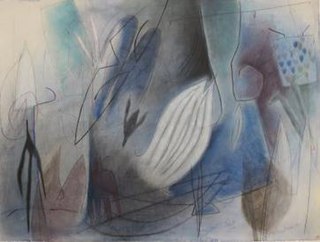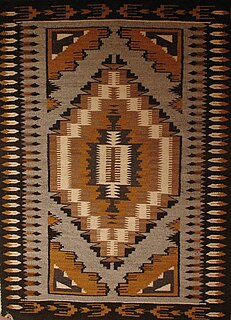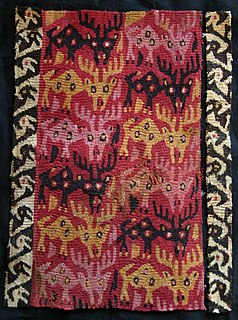
Tapestry is a form of textile art, traditionally woven by hand on a loom. Tapestry is weft-faced weaving, in which all the warp threads are hidden in the completed work, unlike most woven textiles, where both the warp and the weft threads may be visible. In tapestry weaving, weft yarns are typically discontinuous; the artisan interlaces each coloured weft back and forth in its own small pattern area. It is a plain weft-faced weave having weft threads of different colours worked over portions of the warp to form the design.

Fiber art refers to fine art whose material consists of natural or synthetic fiber and other components, such as fabric or yarn. It focuses on the materials and on the manual labor on the part of the artist as part of the works' significance, and prioritizes aesthetic value over utility.

Emmi Whitehorse is a Native American painter and printmaker. She was born in Crownpoint, New Mexico and is a member of the Navajo Nation. She lives in Santa Fe, New Mexico and grew up on the open land northeast of Gallup, New Mexico in a family where only the Navajo Language was spoken.

Gallup station is an Amtrak train station at 201 East Highway 66 in downtown Gallup, New Mexico. It is the second busiest station in the state, with more than 16,000 boardings and alightings in 2014.

Navajo rugs and blankets are textiles produced by Navajo people of the Four Corners area of the United States. Navajo textiles are highly regarded and have been sought after as trade items for over 150 years. Commercial production of handwoven blankets and rugs has been an important element of the Navajo economy. As one expert expresses it, "Classic Navajo serapes at their finest equal the delicacy and sophistication of any pre-mechanical loom-woven textile in the world."

A photo blanket is a large, rectangular piece of fabric displaying images, pictures, or designs, often with bound edges, used as a blanket or decorative object. Historically photo blanket were made of thick cloth depicting people, objects, and symbols intended to tell a story or reveal historical events.

Textile arts of indigenous peoples of the Americas are decorative, utilitarian, ceremonial, or conceptual artworks made from plant, animal, or synthetic fibers by native peoples of both North and South America.

Art of the American Southwest is the visual arts of the Southwestern United States. This region encompasses Arizona, New Mexico, and parts of California, Colorado, Nevada, Texas, and Utah. These arts include architecture, ceramics, drawing, filmmaking, painting, photography, sculpture, printmaking, and other media, ranging from the ancient past to the contemporary arts of the present day.
Pablita Abeyta was a Native American activist and sculptor born in Gallup, New Mexico, United States. The eldest daughter of Sylvia Ann (Shipley) Abeyta and artist Narciso Abeyta, her family was originally from the Cañoncito Band of the Navajo Reservation in New Mexico, located west of Albuquerque, which changed its name in to To’Hajiilee in 2000.

Alice Kagawa Parrott was a Japanese American fiber artist and ceramicist. She spent most of her adult life in Santa Fe, New Mexico, where she established a reputation as one of the country's most important weavers, and opened one of Santa Fe’s first shops devoted weaving and crafts.
Agueda Salazar Martínez, also known as "Doña Agueda," was an American artist, noted for her Chimayo-style woven rugs and blankets.

Ramona Sakiestewa is a contemporary Hopi Native American artist who lives and works in Santa Fe, New Mexico. Sakiestewa is renowned for her tapestries, works on paper, public art, and architectural installations.
Rebecca Salsbury James (1891–1968) was a self-taught American painter, born in London, England of American parents who were traveling with the Buffalo Bill Wild West Show. She settled in New York City, where she married photographer Paul Strand. Following her divorce from Strand, James moved to Taos, New Mexico where she fell in with a group that included Mabel Dodge Luhan, Dorothy Brett, and Frieda Lawrence. In 1937 she married William James, a businessman from Denver, Colorado who was then operating the Kit Carson Trading Company in Taos. She remained in Taos until her death in 1968.
Irene Hardy Clark is a Navajo weaver. Her matrilineal clan is Tjbahj and her patrilineal clan is Honjghjahnii. Her technique and style is primarily self-taught, incorporating contemporary and traditional themes.
Nanibah "Nani" Chacon is a Diné and Chicana painter, muralist, and art educator. She has had art installed at the IAIA Museum of Contemporary Native Arts in Santa Fe, the Navajo Nation Museum in Window Rock, the ISEA International Arts and Technology Symposium, Old Town Lansing, and in the "Que Chola" Exhibition at the National Hispanic Cultural Center in Albuquerque, among other venues.
D.Y. Begay is a Navajo textile artist born into the Tó’tsohnii Clan and born from the Táchii'nii Clan.
Melissa Cody is a Navajo textile artist from No Water Mesa, Arizona, United States. Her Germantown Revival style weavings are known for their bold colors and intricate three dimensional patterns. Cody maintains aspects of traditional Navajo tapestries, but also adds her own elements into her work. These elements range from personal tributes to pop culture references.
TahNibaa Naataanii is a Native American traditional artist and a member of the Navajo Tribe. She has espoused a belief that creativity should be allowed to be the source of art and that artists should not have to confine themselves to a particular style. Naataanii has also stated that weaving art and tradition should be passed along to present and future generations, with her art techniques and mediums being the traditional form, and artistic style dependent on the artist.

Barbara Teller Ornelas is an American Navajo weaver, instructor, and author. She is also a cultural ambassador for the U.S. State Department. She exhibits her fine art textiles and traditions at home and abroad.
Daisy Taugelchee was a Navajo weaver. The Denver Art Museum declared Taugelchee is "widely considered the most talented Navajo weaver and spinner who ever lived". In 2004 one of her rugs was featured on a United States Postal Service stamp.











